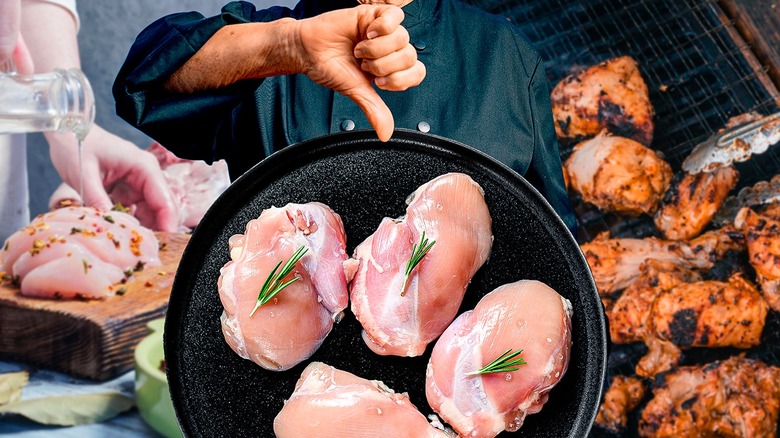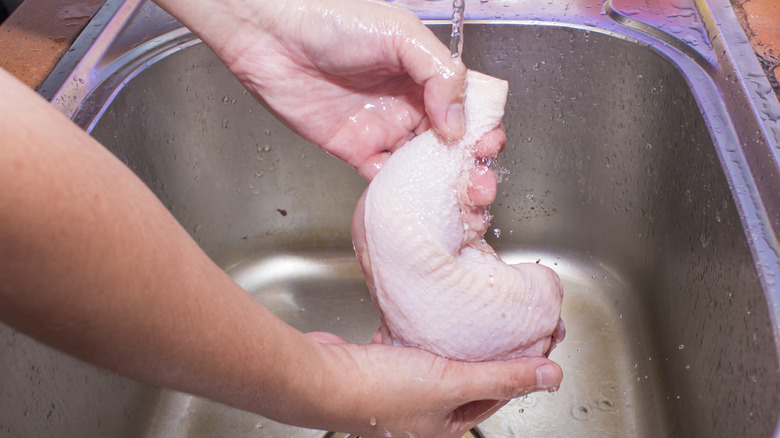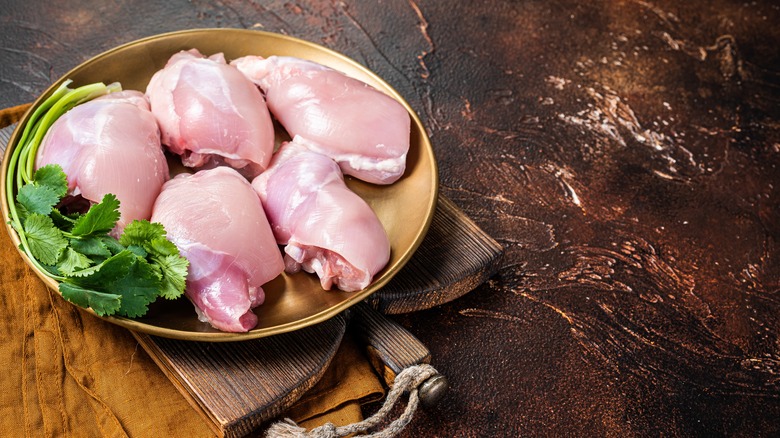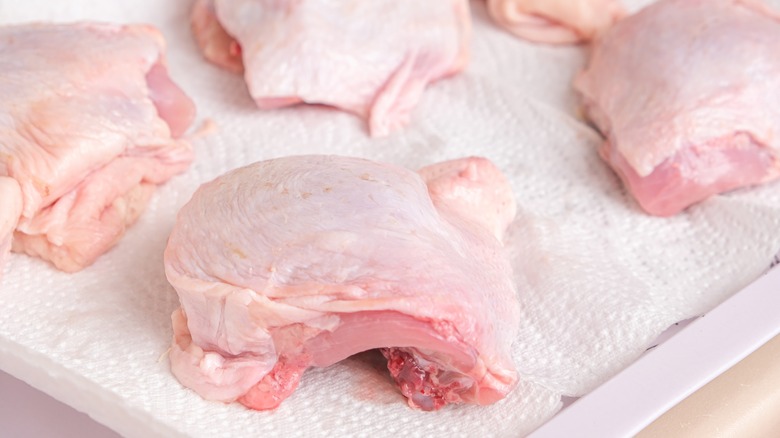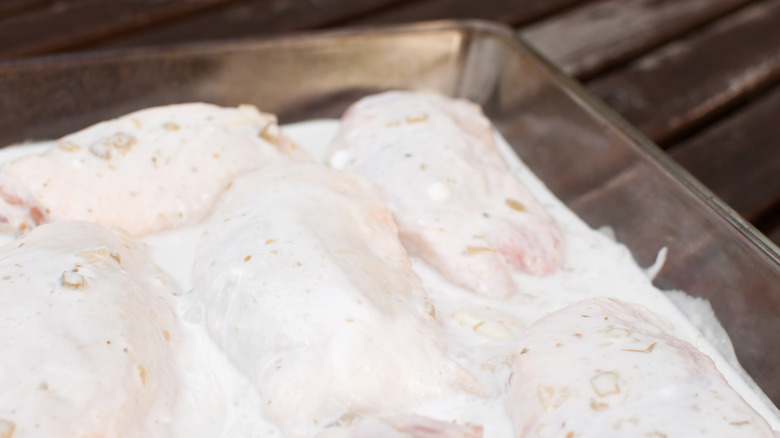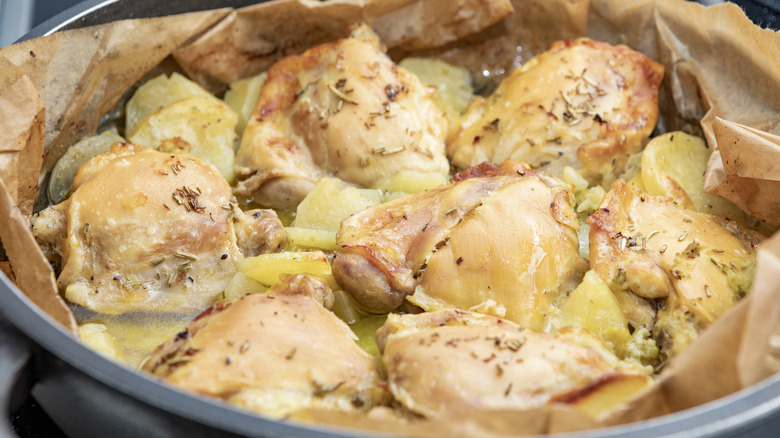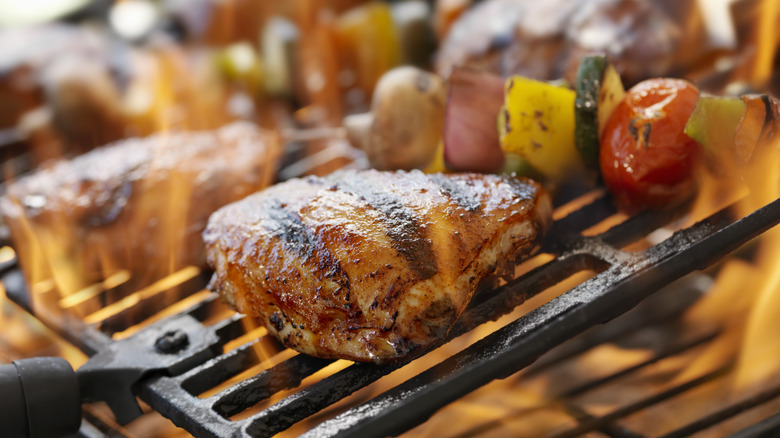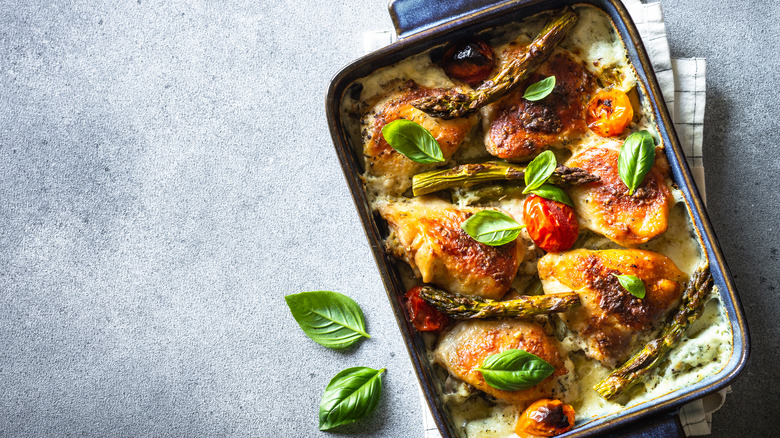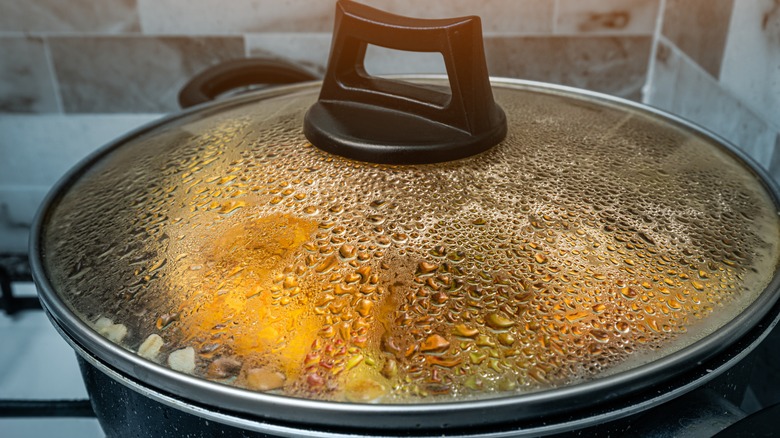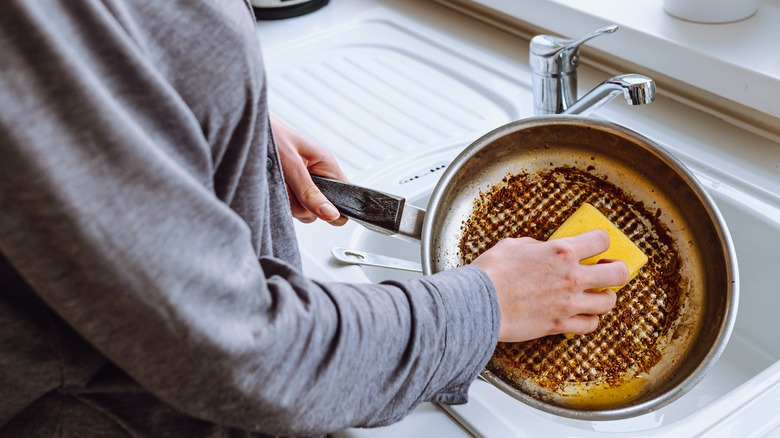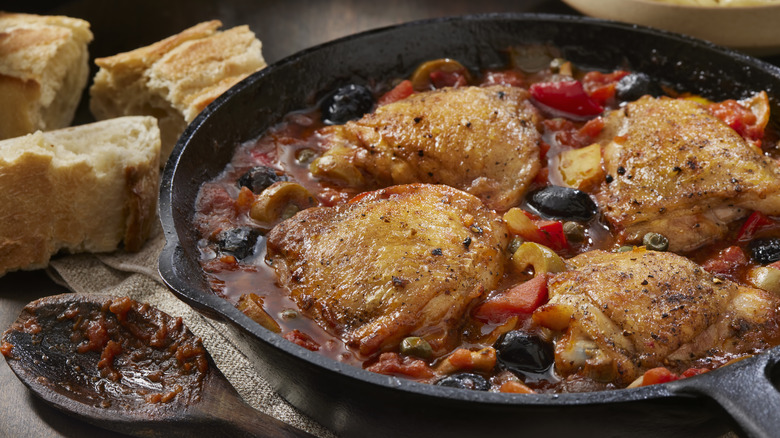12 Mistakes Everyone Makes When Cooking Chicken Thighs
If you haven't given much thought to your chicken choices lately, it's time for a rethink. Many of us automatically grab chicken breasts when shopping, valuing their versatility for baking, grilling, shredding, and adding to soups. On top of that, they're low in fat, an attractive feature for anyone looking for that. However, let's face it — chicken breasts can be pretty bland. It takes a truckload of seasonings, sauces, and fats to make them not just edible but genuinely tasty.
That's why we're suggesting a break from the chicken breast routine and a dive into more exciting cuts. Chicken thighs, in particular, match the versatility of breasts but bring a much richer flavor to the table. Thanks to their densely packed connective tissue, they're also juicier. But, and here's the catch, if not prepared right, they can end up just as dry and tasteless as their white-meat counterparts. To avoid this culinary tragedy, give this article a read before your next grocery run.
Buying the wrong kind
Whether out of convenience or habit, you're probably used to buying boneless, skinless chicken. We're not here to shake up your entire shopping history, but we do recommend rethinking your chicken game when you switch to thighs. First things first, opt for skin-on chicken thighs. The skin plays a crucial role in sealing in moisture and flavors, resulting in a deliciously tender bird. Additionally, it's packed with fats that drip into the meat during cooking, enhancing the overall flavor.
Now, let's talk bones — they're not just obstacles to navigate around. Rather, they contribute to keeping the meat tender and moist. The bone marrow and fat around the bones melt during cooking, infusing the meat with extra flavor and juiciness. If you fail to heed this advice and purchase boneless, skinless chicken thighs, you'll not only miss out on one of the most delicious cuts of chicken, but you'll likely end up with meat that's just as dry and bland as you're used to.
Washing them
Like frying with olive oil and oversalting pasta water, rinsing raw chicken is a bad kitchen habit you need to drop. We understand the temptation to wash off what might seem like slime, especially when dealing with less-than-pristine cuts like chicken thighs. But you're going to have to overcome the ick factor because rinsing raw chicken increases your risk of food poisoning.
At first, this might sound counterintuitive. How could washing make things riskier? Well, one reason is that rinsing might remove the chicken's protective outer layer, exposing the meat to potential contaminants. But the bigger issue is the risk of cross-contamination. Rinsing chicken often leads to splattering raw meat liquids onto surfaces like the sink, counter, and cutting boards. If not cleaned promptly, these areas can unwittingly become sources of contamination for other food preparations. A better approach is to keep the chicken in its packaging until you're ready to cook it. Another key safety measure is ensuring that the chicken reaches the recommended internal temperature of 165 F, per the CDC. This cooking temperature eliminates any bacteria present in the meat, making sure your meal is safe to enjoy.
Removing the skin
Getting past your initial hesitation to purchase skin-on chicken thighs is only half the battle. Yes, dealing with the lumpy, awkward shape might be a bit tricky, but that's a minor hurdle compared to the idea of keeping the skin intact during the entire cooking process. However challenging it may seem, we strongly recommend against removing the skin from chicken thighs.
If it helps, imagine chicken skin like a saturated sponge eagerly releasing delicious juices into the meat. It doesn't take much to see how that would improve the texture, flavor, and moisture of the chicken thighs. Besides acting as a flavor enhancer, the skin also serves as a protective barrier, shielding the meat from direct heat. This ensures the chicken cooks gently and gradually, a crucial factor if your aim is moist and succulent meat. While we hope we've convinced you of the benefits of keeping the chicken skin on, if you simply can't imagine eating it, there's a compromise. Keep the skin on during the cooking process, then remove it just before serving.
Not patting them dry before cooking
We recognize that there are two distinct groups when it comes to chicken skin preferences. Some people can't discard it quickly enough, while others go as far as to create chicken skin chips. If you're in the first group and plan to ditch the skin before serving, you can skip this step. But for those eager to sink their teeth into the crunchiest chicken skin imaginable, read on.
Getting crispy chicken thighs is ridiculously easy. The key lies in ensuring the skin is dry before the chicken hits the pan. To achieve this, gently pat the skin with a paper towel and season to your liking. If you want to go for extra credit, sprinkle some salt on the thighs and let them rest skin side up in the fridge for at least half an hour. This not only makes the meat tastier but also helps dry out the skin, making it easier to achieve that perfect crispiness.
Forgetting to brine
Chicken thighs, unlike leaner cuts, come with a thickness that makes uniform seasoning tricky. The result is that some parts are bursting, with flavor while others remain bland. Brining chicken is a simple solution to this annoying problem. It's worth noting that while not mandatory, taking the time to brine can seriously level up your chicken thigh game.
Beyond ensuring that the thighs are evenly seasoned, the salt in the brine plays a crucial role in maintaining the meat's moisture during cooking. Additionally, the salt acts as a gentle tenderizer, breaking down muscle fibers for a more tender texture. To brine chicken thighs, immerse the meat in a solution of salted water or buttermilk. For eight chicken thighs, you'll need approximately 8 cups of water and 4 tablespoons of salt. Allow the chicken to soak overnight and pat it dry before cooking. If time is of the essence, there's a quicker option — dry brining. Just sprinkle kosher salt over the thighs and let them sit for a few hours before cooking. It's speedier but delivers nearly identical results.
Using cold chicken in a hot pan
Starting your cooking adventure with a cold skillet might sound a bit odd, especially if you're used to preheating for dishes like stir-fry, pancakes, and burgers. But this unconventional method is exactly what chicken thighs require. Here's why: When you place cold chicken in a hot pan, the outside of the meat is prone to burning. At the same time, the inside stays undercooked.
Fortunately, there's a remedy for this culinary conundrum that doesn't require a major overhaul of your cooking routine. The first step is to leave the chicken out of the refrigerator for 15 minutes before cooking. Room-temperature meat cooks more evenly and is less likely to release its valuable juices while cooking. Working with room temperature chicken, put the thighs skin side down in a cold pan and turn the heat up gradually. This gentle process causes the fat to render slowly, creating extra crispy skin. Evenly cooked chicken that's moist and has crispier than crispy skin? Sounds like a good deal to us.
Not cooking them enough
Cooking white meat can be seriously anxiety-inducing. It's not just talk — the low-fat content and tendency to dry out quickly during cooking make white meat infamous for going from chewy to leather-like in seconds. That's probably why we all feel on edge when trying to whip up dishes like Champagne chicken. Instead of fighting the natural order of things, leave the stress of white meat in the past and turn your attention to dark meat.
Dark meat chicken is a game-changer for a couple of reasons. For one, it's packed with connective tissue that, when cooked, breaks down into gelatin that infuses the chicken with mouthwatering juices. Longer cooking times only improve things, allowing more of these delicious juices to seep. Chicken thighs, in particular, become even more flavorful and tender, and the best part? No need to stress about overcooking. Unlike white meat, which you should pull out of the oven when it hits 165 F, dark meat can go up to 195 F without losing any flavor or texture. Cooking times will vary, but as a rough guide, pan-cooked chicken thighs usually take about 10 to 15 minutes to cook, while oven-cooked bone-in thighs will take 35 to 40 minutes at 350 F.
Heating them too quickly
Somewhere along the way, our approach to cooking took a detour into impatience. Whether it's because our schedules are busier than ever or because meal delivery kits make everything seem instant, we've forgotten that some meals require a touch of patience to truly satisfy our taste buds.
This is particularly true when dealing with chicken thighs. Thanks to their high-fat content and density, chicken thighs need more time in the oven than their white meat counterparts. Boneless thighs take around 20 to 30 minutes at 350F, and if they have bones, add an extra 15 minutes to that. Pan-searing boneless thighs? Plan for five to seven minutes per side, totaling 10 to 14 minutes. Tack on a couple more minutes for bone-in thighs.
We get it, there's a temptation to crank up the heat for a faster finish, but resist that urge. Quick heating and direct flames might lead to burnt skin, depriving you of the crispy golden goodness that patience can deliver. When cooking chicken thighs in a pan, start with a cold pan and slowly increase the heat to medium-low. If you're using the oven, remember the mantra: slow and low. Giving the connective tissue the time it needs to melt and infuse the meat is the key to achieving tender thighs.
Overfilling the pan
When time is tight and you're cooking for a crowd, taking a few shortcuts is practically a necessity. Maybe it's opting for instant rice instead of the regular kind, or using a pre-made sauce instead of whipping up your own. These tiny cheats won't derail your dinner plans, but there's one shortcut that could mess with the heart of your meal — cramming too many chicken thighs into the pan.
On the surface, it might not seem more troublesome than your usual kitchen shortcuts, but the fullness of your pan is directly linked to the quality of your finished chicken thighs. When chicken thighs are squeezed into a pan, the steam released by each thigh disrupts the browning process, preventing the skin from achieving that coveted crispy texture. Moreover, every additional piece of chicken lowers the pan's temperature. That means any liquids released by the chicken that would normally evaporate in a hotter pan end up sticking around, increasing the humidity and further thwarting your crispy skin goals. Combat this issue by leaving a few inches of space between each piece of meat. Depending on the quantity, that will probably mean cooking in batches.
Covering the pan
Just as crowding the pan with chicken thighs creates too much moisture buildup, covering the pan during cooking presents a similar issue. If you've ever made soup or rice, you'll recognize this situation. When you cover the pan, steam gets trapped, forming condensation on the inside of the lid. This, in turn, elevates the humidity within the pan, and those water droplets go right back into whatever you're cooking.
While this isn't a problem for soup or rice, it spells major trouble for chicken thighs, especially when striving for that perfect crispy skin. Any extra moisture, be it steam or condensation, prevents the skin from drying out, a key factor in achieving that sought-after crispiness. Fortunately, steering clear of this hiccup is simple — just avoid covering the pan while cooking. This advice applies to the resting period, as well. Covering the pan traps steam, causing the skin to lose its desired crispness and take on a rubbery texture, which is definitely not a vibe.
Tossing the fat
Chicken fat — just hearing the name might conjure up visions of random meat pieces floating in a greasy, oily puddle. It's no wonder we're in such a hurry to chuck it away. But despite its unappealing appearance and name, chicken fat is a surprisingly valuable (and free) ingredient that's worth holding onto. With a mild, meaty flavor, chicken fat can enhance the taste of vegetable side dishes that pair well with chicken thighs.
For instance, it works wonders in sautéed kale, green beans almondine, or pan-fried potatoes. Combine the chicken drippings with butter, flour, and chicken stock, and you've got a delectable chicken gravy perfect for drizzling over mashed potatoes. The possibilities don't stop there — blend leftover chicken fat with butter, cream, and a bay leaf, and you've created chicken butter, a luxurious spread that goes with everything from toast to corn on the cob. Or how about using warm chicken fat as an oil replacement the next time you make homemade mayonnaise? As you can see, chicken fat deserves a lot more credit than it receives.
Limiting preparation style
This final tip is less about pointing out a mistake and more about encouraging culinary exploration. If you're just dipping your toes into the realm of chicken thighs, you might be tempted to stick to familiar recipes, like Italian Baked Chicken Thighs or Pan-Fried Chicken Thighs, out of fear of venturing into the unknown. On the flip side, seasoned chicken thigh enthusiasts might find comfort in revisiting their go-to recipes repeatedly. While having a few trusted favorites in your recipe repertoire is perfectly fine, chicken thighs offer endless possibilities. If you're not experimenting with new techniques, you might be missing out on some seriously delicious meals.
Consider the wide array of Asian-inspired dishes that showcase chicken thighs, such as Homemade General Tso's Chicken, Thai Chicken Curry, and Filipino Chicken Adobo. Venturing into European cuisine, chicken thighs shine in recipes like Easy Chicken Gyros and Mediterranean Grilled Chicken. The next time you toss chicken thighs into your shopping cart, keep these diverse recipes in mind and challenge yourself to try out new preparation styles — you'll be glad you did.
Static Media owns and operates Tasting Table and Mashed.
